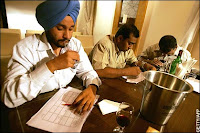 Shillong, India: There is a saying in New York that when a man takes his date to a restaurant and orders a bottle of Chateau Margaux, he must be ready to pop the question.
Shillong, India: There is a saying in New York that when a man takes his date to a restaurant and orders a bottle of Chateau Margaux, he must be ready to pop the question.
After all, when you spend $402 on a glass of wine, you will have little left in your purse for another date for at least the next three months!
But for the simple thirsty soul who can look beyond his Chateau Margaux, which is as much about snob factor as taste, events like the Shillong Wine Festival are fast becoming must-visits, accompanied by Bacchus’s brothers from across the globe.
Global and Shillong wine?
Before you choke, hear what Swedish tourist Ionis has to say.
Ionis arrived in this hill town last week with one agenda — to see, feel and taste Shillong’s very own sohiong wine.
Last evening, Ionis had his fill of the famous wine made from black cherries — sohiong is the local name of the fruit — surrounded by wine-makers and connoisseurs, at the All Saints’ Hall where the fourth Shillong Wine Festival was held.
Between sips of fine red wine on the chilly Shillong evening, Ionis said he first heard about the wine festival “from a friend from Vietnam whom I met in Sikkim. I decided to came right away”.
Of all the wines he has tasted, the sohiong wine was the best, he declared.
Ionis was joined by Lachlan and Brigid, tourists from Scotland and the US — they chose to identify themselves only by their first names — who were admittedly drawn to Shillong by the wine festival, organised by Forever Young Club.
A local band, Vibes, played live while local designers showcased their creations.
Wine, music and fashion flowed freely.
Besides sohiong, the fourth Shillong Wine Festival offered wines made from plum, jackfruit, ginger, banana, peach, mango, pear, passion fruit, mulberry, apple orange and pineapple.
The home wine-making culture in Shillong is growing fast and more and more youngsters are taking it up as a profession.
Of course, there are some like John M.S. Kharkongor, for whom it is just a hobby.
But Kharkongor stills feels that the state government should promote wine-making and declare it as a cottage industry.
“The state government should delink the excise duty to promote home wine-making so that the wine made from local fruits can be exported without any excise duty.”
“A lot of young people are making wine these days and even my grandchildren are taught to make wine. This can also improve the economy of the state,” said Kharkongor.
Rebecca Khonglah, who took up wine-making six years ago, vouched for the local-ness of the wines. “We are making wine purely from the local fruits,” said Khonglah.
Wine made of banana brought from Arunachal Pradesh was another attraction.
For visitors, the Shillong Wine Festival is popular for its “method”.
“First you taste the wine free of cost and if you are interested, you can buy the same,” said a visitor who bought three bottles of sohiong wine. The bottles were priced between Rs 200 to Rs 250.
The UPS of the festival, said Michael Syiem, president of Forever Young Club, was that all the wine was made from “surplus fruit”.
“We see a lot of fruits wasted, especially in rural areas where they grow in abundance. In this context, the wine festival is a forum to exhibit and sell home-made wine made from surplus local fruits,” said Syiem.
The Forever Young Club now wants the Meghalaya government to help the home wine makers by giving them licence so that their products can be exported commercially.
The state government is not taking any initiative to promote wine made from indigenous fruits, despite its huge potential, he said.
With the government harping on the Look East Policy, wine makers should be able to export their products to neighbouring countries provided they get adequate assistance, Syiem added.
